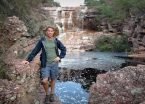
Heading inland from Brazil’s littoral, I happily landed in the former diamond-mining town of Lençois, so-named for the miners’ crude tent camps that resembled lençois (sheets) from afar. In the late 1800’s richness came to this area in Brazil in spite of its relatively poor-quality gemstones. The cloudy diamonds were sold to the French who needed them to help dig the Panama Canal, the London Underground and other fin de siècle tunnel projects in Europe.
When mining ended a few decades ago and the Chapada Diamantina National Park was established, Lençois turned to tourism. Crumbling colonial homes and buildings were renovated, cobblestone streets and plazas spiffed up, tour operators opened shop. The result is a delicate balance of between reserved locals who still follow caipira (i.e. rural) traditions and eco-tourists who flock to the town in search of the great outdoors.

Lençois is perfectly suited for independent travelers. With good accommodation, a steady stream of backpackers for companionship, and excellent dining at the many outdoor eateries – it’s touristy yet low key. I found Lençois to be the perfect place to spend a few days hiking and taking in its many outstanding features.
Trek to Cachoeira da Fumaça
Eager to stretch my legs after many days lounging on the beach, I booked a hike to Brazil’s highest waterfall, Cachoiera da Fumaça (Smokestack Waterfall), through one of the tour agencies. Three chatty Brazilians from São Paulo were my companions as we climbed the windswept canyon in Vale do Capão (they later posted this about our day – big ups to my fellow travel bloggers!)
Cachoeira da Fumaça is unusual in that the waterfall does not reach its base. Rather the water is blown back over the top and evaporates – giving it the appearance of a smoking chimney. This is due to the 420 meter (1400 feet) drop, strong upwinds from the canyon, and the small river which feeds the waterfall.
It’s a wonderful spectacle and hard to give it justice in words so I’ve created the short video below.
Lençois Surroundings
The next day I toured some of the sights in the national park. Chapada Diamantina is enormous, packed with incredible wilderness, hidden waterfalls and deep caves. The only real way to fully appreciate it is to go on a multi-day trek which sadly I didn’t have time for since I was scheduled to arrive soon at my WWOOFing farm. A down-and-dirty day tour was my best alternative.
We climbed to Morro de Pai Inácio to take in the marvelous vistas of the table mountains that resemble a greener American Southwest. The morro‘s name derives from a local legend in which a slave, Ignatius, fell in love with the wife of a powerful colonel. When the husband found out he sent gunmen in pursuit and Ignatius, trapped at the top of this mountain, threw himself into the abyss. It is said that his spirit delivers spectacular sunsets from this spot as an expression of his enduring love.
We went caving in Gruta da Lapa Doce to explore its silence and stalagmites/stalactites (and stuffiness). We snorkeled in the impressive azure waters of Gruta da Pratinha. We trekked along the roaring Rio Mucugezinho to Poço do Diabo (Devil’s Well) where supposedly escaped slaves, once caught, were thrown to their deaths as a deterrent to future runaways.

A highlight of the day was the lunch served at a dusty adobe home in the remote sertão scrubland. I was initially skeptical but once clay pots filled with roasted vegetables from the wood stove appeared I was won over. Farm-fresh eggs, homemade sauces, whipped manioc, piles of beans and rice, grilled meats, and sweet caramel doce de leite – a home-cooked feast for everyone. It remains my best meal in Brazil.
Nearby Waterfalls

I took full advantage of the nice walks from Lençois town which can be done independently. The few easy kilometers to Riberão do Meio ends at a rockin’ natural waterslide. I made several gleeful descents only to pay for it the next day with a sufficiently sore backside.
I walked up the Lençois River past the Cachoeira Serrano rapids where locals enjoy bathing in the refreshing pools. The site affords marvelous views of Lençois town and surrounding greenery. Further upriver I encountered more waterfalls with nary a soul present. Chapada Diamantina is crowded with captivating cachoeiras – one could spend weeks (and some do) in search of them throughout the region’s vast wilderness.
Rugged Beauty in an Austere Land

Chapada Diamantina is as climactic as it is challenging. For centuries the people here have struggled. First the area was an adverse home to runaway slaves fleeing sugar plantations on the coast. Later the diamond boom promised much but yielded little for the poor migrants that rushed here with great hopes.

~ Rustic pau-a-pique (stick and adobe) homes can still be seen in the harsh landscape
Today the poor croppers who work the rough sertão soil face a searing dry season where rain does not fall for six months or more. More severe droughts force them off their farms in search of livelihood elsewhere. Despite its intense beauty and a playground for outdoor enthusiasts, Chapada Diamantina is not a land of milk and honey for farmers.





















I sure hope someone was holding on to your feet !
Hey Paul, no safety procedure required for the photo, it’s actually a trick angle since there’s a ledge right below it. Not nearly as dangerous as it looks. 🙂
That waterfall is crazy! Nice colors captured in photos. I wish we were more colorful up here. What a trip!
Thanks Erik, it was quite a sight. Brazil is a technicolor country, and I’m now here in the Amazon where I’ve never seen more shades of green.